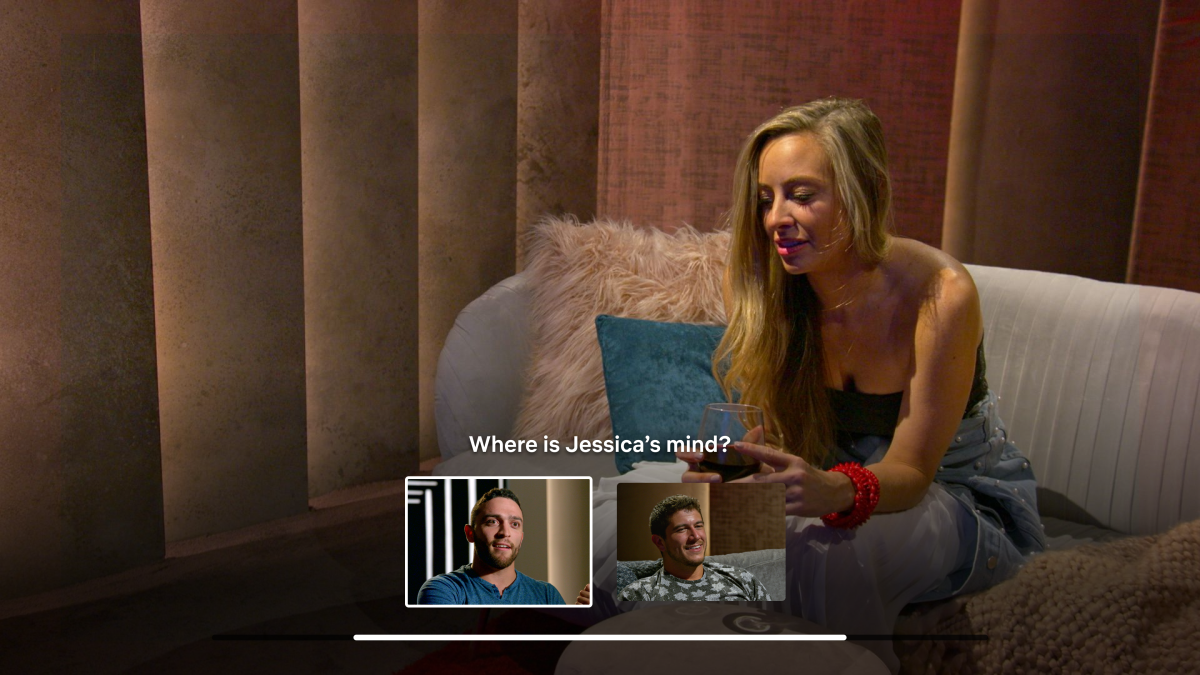Why Netflix is using polls on ‘Love Is Blind’ and other shows

- Share via
On Netflix reality dating show “Love Is Blind,” contestant Jessica Batten wasn’t sure who she’d rather be with — project engineer Matt Barnett or fitness instructor Mark Cuevas.
“At this point, I can see them both being my husband — which is crazy,” Batten said.
The show, released last year, struck a nerve during the COVID-19 pandemic with its premise of singles meeting potential partners behind a screen, unaware of what they look like. But there wasn’t a way for viewers to express how they felt about scenes within Netflix, so many people took to social media sites like Twitter and Reddit. Soon, they’ll get a chance to share their opinions directly on the streaming service.
This month, the Los Gatos, Calif.-based company will test new interactive polls for some of its subscribers on four shows, including “Too Hot to Handle” and “Love Is Blind.” For example, on “Love Is Blind,” a poll question will appear on the screen after contestant Batten’s confessional asking viewers to decide which man she is thinking about more. Once viewers make their selection, they’ll see the results, based on who is watching that day.
“Love Is Blind” bursts with saturated colors and well-framed shots, but it’s simply a layer of artifice that can’t distract from the shoddy script.
Netflix executives hope the feature will increase the amount of engagement on its platform and foster a communal, shared viewing environment for its subscribers at a time when the streaming giant faces mounting competition for eyeballs.
“They choose what they want to watch when they want to watch it, and offering these engaging features is just another way to get the diverse set of experiences to them,” said Angela Morgenstern, vice president of product content innovation for Netflix. “It’s really not about hitting a specific metric ... it’s more around how can we create experiences that expand the storytelling, that bring our audiences closer and more immersed to the stories that they love?”
The new feature comes at a time when Netflix faces a slowdown in subscriber growth as rivals including Disney+ and HBO Max, and other entertainment apps like TikTok, expand their reach. Companies have tried to differentiate themselves based on content, but in the era of voluminous streaming libraries and binging, it has become more challenging to create water cooler moments where everyone is watching the same show at the same time.
Although Netflix won’t use the polls to change storylines, the online interactions could create a more communal environment, giving viewers added incentive to keep watching, analysts said.
“This allows people to feel like they’re watching it with someone else, to feel like they’re having the same thought or different thoughts from someone else, and that level of interactivity and engagement encourages people to come back week after week, or episode after episode, to watch,” said Julia Alexander, senior strategy analyst at Parrot Analytics.
Polls could also help better familiarize viewers with an interface that’s different from passive, linear television viewing. And it could benefit Netflix as it diversifies its programming to include video games. The company said in July it plans to add mobile games to its large library of films and series.
“Netflix is about to become a much more interactive platform,” Alexander said.
Ever screamed at the television, wishing the character you’re rooting for would follow your advice?
The concept of live polling on TV is not new. Other networks and platforms have polled audiences to make choices that could change the outcome of a show. For example, in one of the versions of the dating TV show “Love Connection,” the audience recommends who the main contestant should date among a number of potential suitors. On ABC’s “America’s Funniest Home Videos” or singing competition “American Idol,” audience votes determine the final champion.
Similarly, programs on Facebook Watch and Twitch have also incorporated polls. A scripted program on Twitch called “Artificial” polled the audience to make decisions in real time throughout its show that would permanently alter its storyline.
Inside the library of a Hollywood Hills home, actress Tiffany Chu gazed expectantly at the camera, waiting for guidance from the audience.
Netflix sees polls as an extension of its interactive programming that includes “Choose Your Own Adventure”-like shows and movies. Viewers on certain programs are asked to select a choice on their screen on what a character should do, and their choice causes the story to take a different turn. Netflix has made 12 such branching narratives since 2017.
“We are really kind of at that sweet spot between technology and content,” said Dave Schlafman, director of design, interactive experiences for Netflix. “It means we can innovate around storytelling because we are so ingrained and we are so collaborative and it really enables us to tell stories that couldn’t be told on linear platforms.”
One of Netflix’s best-known interactive programs was the 90-minute “Black Mirror” film, “Bandersnatch.” Many fans re-watched the 2018 film multiple times to try to uncover all of its endings.
In June, Netflix extended its interactive shows to the non-scripted category with a mindfulness and sleep guide program called “Headspace: Unwind Your Mind.”
The program caters to how viewers are feeling, creating a personalized viewing experience. Subscribers select from different choices on their screen of what they are seeking from the show, whether it’s helping them go to sleep or relaxing from a stressful day and the content that follows is tailored to what they pick.
The ability to use interactive technology has been appealing to many creatives and something that Netflix believes sets it apart.
Company executives say polling gives viewers an opportunity to personalize their experience on the streaming platform.
“Polling is going to enable us to really explore how choices can lead to connection,” Schlafman said. “We think this will make viewers feel like they’re part of a larger Netflix community in making choices and we also think it’s going to help spark conversation, whether that’s sitting next to your family or friends on a couch or starting that conversation online with followers or friends.”
More to Read
Inside the business of entertainment
The Wide Shot brings you news, analysis and insights on everything from streaming wars to production — and what it all means for the future.
You may occasionally receive promotional content from the Los Angeles Times.












